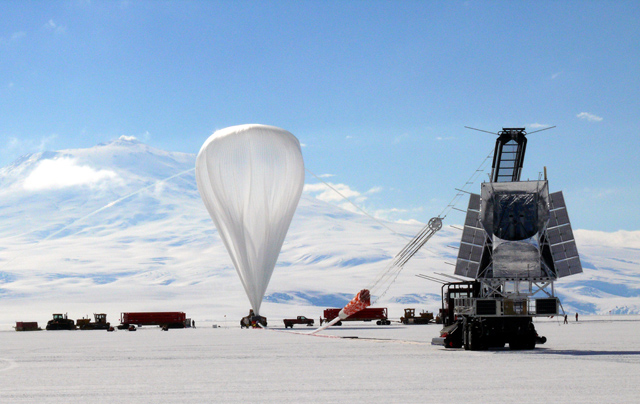|
Starlight, starbrightBLAST knocks off the dust from distant galaxies to provide new view of the universePosted April 10, 2009
After two years analyzing data from the Balloon-borne Large-Aperture Sub-millimeter Telescope (BLAST) Led by Mark Devlin Flying the telescope above much of the atmosphere allowed the BLAST team to peer out into the distant universe at wavelengths nearly unattainable from the ground to help solve a mystery that began years ago. More Information
In the 1990s, NASA’s COBE satellite “Stars are born in clouds of gas and dust,” explained Barth Netterfield The Nature study combines BLAST submillimeter observations at wavelengths around 0.3 millimeters — between infrared and microwave wavelengths — with data at much shorter infrared wavelengths from NASA’s Spitzer Space Telescope “For weeks in 2006 and early 2007, BLAST traveled over Antarctica making maps of the submillimeter sky,” said Devlin, the project’s principal investigator (PI). “We measured everything, from thousands of small clouds in our own galaxy undergoing star formation to galaxies in the universe when it was only a quarter of its present age.” In one 11-day balloon flight, BLAST found more than 10 times the total number of submillimeter starburst galaxies detected in a decade of ground-based observations. The scientists say this “rich data set” is being mined for further information about these dust-enshrouded galaxies to lean more about their evolutionary history, any relationship with other galaxies, and associations with larger-scale structures in the universe. “BLAST has given us a new view of the Universe,” said Netterfield, the Canadian PI for the project. “The data we collected enable us to make discoveries in topics ranging from the formation of stars to the evolution of distant galaxies.” NSF-funded research in this story: Mark Devlin, University of Pennsylvania. |



For USAP Participants |
For The Public |
For Researchers and EducatorsContact UsU.S. National Science FoundationOffice of Polar Programs Geosciences Directorate 2415 Eisenhower Avenue, Suite W7100 Alexandria, VA 22314 Sign up for the NSF Office of Polar Programs newsletter and events. Feedback Form |


